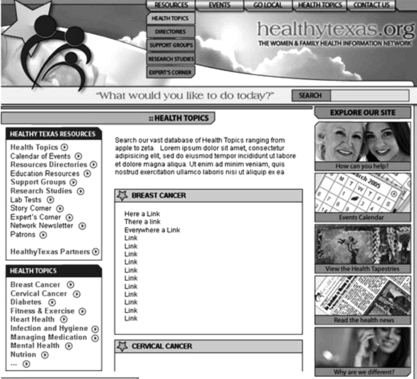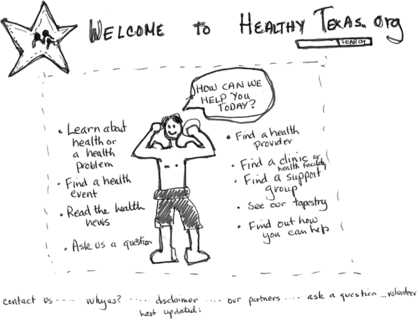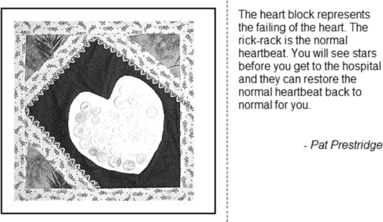ABSTRACT
Over a period of 8 years, 40 health organizations in South Texas came together to develop a plan for a Web site that would provide regional health information, directories, and opportunities for health consumers to share experiences in health and disease. The result was Healthy Texas <http://www.healthytexas.org>. This portal had vision and promise and may yet achieve its potential if the partners are willing to continue their commitment. The experience has implications for others undertaking a regional consumer health Web portal.
INTRODUCTION
Healthy Texas <http://www.healthytexas.org> is a Web portal designed for lower-health literacy, lower-computer literacy audiences in South Texas. The portal is unusual because it was the vision of more than 40 health care organizations. These groups came together, starting in 1999, because there was no single Web portal that underserved populations could use to find information about regional health care. From 1999–2002, community partnerships developed until the Women and Family Health Information Network emerged in response to fragmentation of local health services, limited access to local health information, literacy and language barriers to health information, and frustration with communications between provider and patient.
THE NETWORK
In 2002, the groups formed a 501c3 nonprofit organization for health information, the Women and Family Health Information Network (the Network). Stakeholders included city and county government organizations, educational institutions, health providers, community organizations, corporations, nonprofit organizations, legal organizations, an ethics team, and medical, technology, and information partners. Specifically, the Network included groups such as the San Antonio Affiliate of the Susan Komen Foundation, the Alamo Breast Cancer Foundation, the San Antonio Metropolitan Health District, United Way of San Antonio and Bexar County, the Alamo Area Council of Governments, and many other groups. The Network had multiple aspects of organization, with a board of directors, an international board, an ethics board, and an honorary board. The Network attempted to be inclusive of the community, rather than exclusive.
The mission of the Network was to improve access to information about local health resources, services, and support, and to promote health literacy through health communications and education. The goals of the group were to:
Create a one-stop regional health information Web gateway in partnership with content experts | |||||
Improve access to health information, services, and support | |||||
Support health-based decision-making | |||||
Promote healthy lifestyles | |||||
Promote health literacy | |||||
Connect separate silos of information | |||||
Conserve limited regional resources | |||||
Minimize duplication of effort | |||||
THE ROLE OF THE LIBRARY
In November 2003, the Network executive director contacted the director of the Briscoe Library at the University of Texas Health Science Center at San Antonio to ask about a partnership to build and maintain what became known as the Healthy Texas Web site. The original vision of the group was for a site that would provide links to basic health information, regional resources for care, and services to have health care questions answered. However, Network members were unaware of National Library of Medicine's MedlinePlus database for consumer health and the Go Local directory initiative to link health topics to local services. Even when these resources were demonstrated, the Network still saw a need for a regional portal that could continue to unite them, allow the community ongoing opportunities to define information priorities and contribute content; and provide resources that were particular to the needs of the region. Rather than duplicate the work of the National Library of Medicine, the Briscoe Library attempted to assure that Healthy Texas met specific and unique regional needs. The Briscoe Library partnered with the Network and in 2004 helped to find funding through AT&T/SBC and Frost Bank to develop Healthy Texas. In February 2005, Healthy Texas, the Web portal of the Network, and the Briscoe Library went live.
THE WEB PORTAL
Design
The design of the Healthy Texas Web site is one thing that sets it apart. Generally pleasing to the audience, it is intended for lower computer literacy and lower health literacy audiences, but it has also been criticized by more sophisticated audiences for being overly simple. However, the original design for Healthy Texas had frequently been criticized for being overly complex and trying to be “all things to all people.” In addition, the design was expensive, having been developed by a commercial site developer (see Figure ).
After months of frustration with commercial developers, the authors proposed a completely new design. The image of a young boy was selected to welcome users to the site and to appeal to bilingual women (who are most often concerned with the health of the family). This new image tested well with promotoras. The rough drawing (see Figure ) emerged as a very different Web design (see Figure ) from the initial work and has generally met with a positive response.
Content
Healthy Texas provides three main services: basic information on health topics of regional interest; a directory of regional health services; and opportunities for the community to contribute to the site by sharing personal health stories, art, and poetry.
Health Topics
Healthy Texas includes basic health information on topics that are of interest to those living in South Texas. Most topics were identified in Healthy Border 2010 1 as being of concern to those living along the Texas-Mexico border. In addition, community members identified other topics of local interest. Community members contributed by writing drafts of basic health information and providing information on local events to the calendars. Health topics were then reviewed by local physicians and other health care providers. The pages were reviewed and edited by an expert in plain language to assure they were clear and concise and written at the sixth grade reading level. For more information, people are given quick links to complete information in MedlinePlus.
The Directory
The site includes a directory of regional health care providers, facilities, and services. There is contact information for physicians, counselors, clinics, nursing homes, support groups, and more. This database is used to populate both the Healthy Texas directory and also MedlinePlus's Lone Star Go Local.Citation2
Health Consumer Contributions
Perhaps the most unique aspect of Healthy Texas is the contributions made by community members. In addition to providing the initial vision and impetus for the health portal, consumers contributed personal art, health stories, and poetry to Healthy Texas. A community health tapestry was developed and donated to the Briscoe Library. Tapestry squares document poignant health journeys. In one example, the author quilted a beautiful heart, embellished with buttons and framed in rickrack, to illustrate her heart problem (see Figure ). Another quilt square documents the story of generations of family members who had struggled with bipolar disease, before they were able to discover that certain nutrients had positive effects on their health.
Other community members, who wanted to remain anonymous, related stories with morals, like mini-novelas, about health lessons they had learned. Here is one example:
I don't think I ever saw my mother drink a glass of milk. Also, Mama smoked cigarettes for many years. As she got older, it seemed like Mama's favorite thing to do was grocery shopping. One day she reached up to get a loaf of bread and she felt a pain in her back. She had fractured her spine! Her bones had weakened from osteoporosis.
The doctor recommended she go to a long-term care center to get physical therapy. But Mama was in constant pain, and she just hated it. She was gone within a few months. Now I try to eat my yogurt and take a calcium pill every day in honor of my mom. —Toni
WHO USES HEALTHY TEXAS
Unfortunately, it is difficult to know over time the usage of the site. Some early statistics were lost, and others included reports of spiders and bots used for automatic indexing of Web sites, artificially inflating the usage statistics. However, the most conservative measures of use (unique visitors and visitors who visited more than once) have shown growth over time. Over a one-year period, December 2006 to November 2007, there were 110,951 unique visitors and 25,274 unique return visitors.
A voluntary survey (not a pop-up) on the pages was rarely completed. In a one-year time frame this survey was completed 45 times. Of those who completed the survey, 85% were women. Half had found the site through Google, one-quarter had heard about it through work, and the rest had heard of the site through a news contact or a personal contact. Most used the site to look at health topics. Only 16% had visited the “Art and Health” section, perhaps the most unique aspect of the site. One-third read the information “About Us.”
In general, with those who used the site and responded to the survey, it was well received. Only 4% said they were unlikely to visit the site again. Those who were unlikely to use the site again were looking for directory information that was not found. This demonstrates a disparity between survey responses and actual use, however, as it appears from the unique visitor statistics that an average of one in four unique visitors returned for additional use.
LESSONS LEARNED
One of the first questions asked about Healthy Texas is how people with limited computer literacy can be expected to use a Web resource. The intent for Healthy Texas is that it would be used with a human “link.” This human connection is especially important in Hispanic cultures. People are more likely to use Internet resources if someone they know and respect recommends those sites. The assumption was that someone with computer skills would be working with those who possessed fewer skills. It was envisioned that in many cases this might be a child or teenager, or that it might be a promotora. However, no actual programs using the Web site in this way have yet resulted.
Among librarians, the Healthy Texas portal met unexpected controversy. Those closely involved with MedlinePlus questioned the value of a regional Web site. Others questioned the authority of locally developed health content. The (former) founding executive director of the Network repeatedly responded that the purpose of the site was not primarily to provide health information, but to bring together diverse community health groups and engage its members in robust dialogue about the accessibility, quality, relevance, and cultural appropriateness of health content on the Web. In addition, the portal is designed specifically for regional underserved audiences who have no such Web site.
The founding director of the Network believed that cross-institutional and local community politics were particular challenges. Such a network must carefully balance the needs of academic, corporate, and nonprofit partners. This topic was so interesting that the co-author of this paper has addressed it in her doctoral dissertation.
The future of Healthy Texas relies on rigorous usability testing. Dr. Randolph Bias and advanced graduate students at the University of Texas School of Information were engaged to review the site for usability in 2006. Some of these findings from this review had already been implemented. Others will certainly strengthen the site. The results of the usability testing will be published in a forthcoming article by Bias and others.
Even with the growth of repeat visitors over time, it does not appear that Healthy Texas was used as often as was hoped. However, Healthy Texas was designed to be a regional Web site with specific appeal. Additionally, it has not yet been officially promoted, results from usability testing have not been completely implemented, and funding was more limited than anticipated.
There have been numerous requests by those in other communities worldwide for help in developing similar services. The authors have proposed a shared template that could be used by others, but this concept must be endorsed by the many existing partners.
There is a gap between the vision for Healthy Texas and the reality. Healthy Texas was designed to be a regionally relevant health resource that supplemented MedlinePlus by providing information for a specific audience in South Texas. It is still reaching its potential. To do so, however, it must be:
-
Translated into Spanish.
-
Made especially relevant to regional audiences by including quotes from local health practitioners and opinion leaders, announcements of local advances in translating research into health practice, and possibly relating regional folk remedies to evidence-based practice.
-
Used in partnership with public schools and community health providers.
-
Updated on a regular basis.
-
Promoted at regional health fairs and community activities
All of these activities require ongoing effort, commitment, and funding, which have not been easily obtained. However, the community process for building Healthy Texas has been rewarding and unifying. One obvious outcome has been the development of an even more comprehensive and inclusive community health group.
The authors would like to thank the SBC Foundation/AT&T and Frost Bank for funding this project. Thanks also to Carolyn Marshall, Lynda Howell, Katie Prentice, Tom Raymond, Randolph Bias, Anna Tubbs, Dean McCall, and the many members and friends of the Network.
Additional information
Notes on contributors
Mary Moore
Mary Moore, PhD ([email protected]) is Executive Director, Louis Calder Memorial Library, Miller School of Medicine, University of Miami, P.O. Box 016950 (R-950), Miami, FL 33131.Deborah Kaercher
Deborah Kaercher, MPH, PhD ([email protected]) is Founding Executive Director, Network for Women and Family Health Information, San Antonio, TX. Her mailing address is 14455 Santa Rita, Helotes, TX 78023.REFERENCES
- United States-Mexico Border Health Commission/Cómision de Salud Fronteriza México-Estados Unidos . Healthy Border 2010: An Agenda for Improving Health on the United States-MexicoBorder . October 2003 Available: <http://www.borderhealth.org/files/res_63.pdf>. Accessed: December 19, 2007.
- Howell , L. , and Prentice , K. “The Creation of Lone Star Go Local for South Texas.” Journal of Consumer Health on the Internet 11 , no. 3 ( 2007 ): 13 – 34 .



